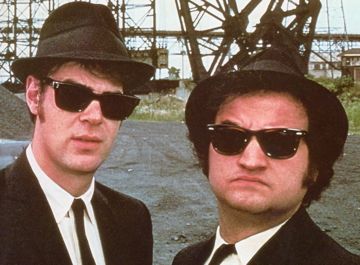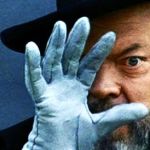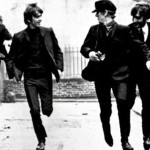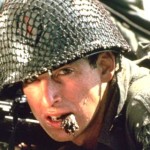 The Blues Brothers: Two white TV comics who dared to sing the blues and, incredibly, came out king bees.
The Blues Brothers: Two white TV comics who dared to sing the blues and, incredibly, came out king bees.
John Belusi and Dan Aykroyd’s R&B musical plays like a honey-dipped harp, even after 30 years. Now it’s enshrined in HD with Universal’s Blu-ray release of “The Blues Brothers.”
Fans of the “Saturday Night Live” comics and the giants of black music that they proudly showcased should consider this a call for an immediate and enthusiastic upgrade from previous DVD versions.
Sound and vision are outstanding. Much of the cinematography came cloaked in muted colors and persistent grain, but the dark matter gives up more of its secrets via the high definition. What was murk now borders on art. The high-def images (1.85:1) feature drop-dead blacks and (what else) a palate of moody blues. The imagery fits right in with the grit of late-century Chicago.
Purists can’t believe Universal released the audio as a simple “lossy” DTS 5.1 (768k). A curious decision, but the music sounds great, with smooth highs and the LFE repeatedly challenged by the mix’s big-bottom bass. You’ll be too busy dancing to quibble. (A shame, nonetheless.) In any case, the new audio improves on the stand-up sound found on the 2009 DVD.
You might want to hold on to those oldie-goldie “Blues Brothers” DVDs, however, as the Blu-ray offers little in the way of extras.
Both the original theatrical and extended versions of the John Landis-directed film bunk together on a single disc. The original, you may recall, was long MIA on video, until the “25th Anniversary Edition” DVD of early 2009. The original version of “The Blues Brothers” runs 132 minutes and the extended cut boogies across 147 minutes.
Viewers who are in it just for the comedy probably could do without the extra 15 minutes, whose add-ons include a dubious scene of Elwood Blues quitting his day job and an even more drawn-out ending. But music lovers strike it rich — a good chunk of the added time goes to expanding killer performances by James Brown, John Lee Hooker and Cab Calloway.
Brown’s turn as a soul-stirring preacher goes from high gear to higher & higher, the action stretched out a minute and a half. It’s an astonishing sequence, probably the best in the film, as dance and gospel fuse in a spiritual frenzy. Brown’s scorching vocals were recorded live. Yeah, that’s Chaka Khan wailing away in the choir. Turn it up and behold the power and glory.
At full length, John Lee Hooker’s street performance of “Boom Boom” will knock you right down. Originally slashed to 1:15, the number gets its due over full 3 minutes. Hooker is joined by Walter Horon and Pinetop Perkins in the film’s only authentic blues.
The new version of Cab Calloway’s onstage fantasy “Minnie the Moocher” preserves one of the 20th century’s best song-and-dance bits, all class and sass. The performance jumps from 2 minutes to 5. Director Landis recalls in the making-of docu that Calloway was “very unhappy” when told he couldn’t perform his new disco version of the classic, but finally got into the spirit.
Aretha Franklin and Ray Charles’ numbers are the same, with the lip-synching on the sloppy side, but with plenty of soul power. Landis says these artists never perform songs the same way, making post-production dubbing a nightmare. (Note that the added material in the extended version is not up to HD standards, for whatever reason.)
The best extra on the new Blu-ray dates back to 1998: the hourlong documentary “Stories Behind the Making of the Blues Brothers.” About as definitive as a history of the movie and band is going to get, the docu was ported over from the two previous DVDs.
A big part of the “Blues Brothers” story is how Belushi and Aykroyd lifted up their R&B/soul heroes. Hard to imagine today, but these hall of famers struggled in the era of disco and punk. “Except for Ray Charles, most of the people weren’t working,” Landis says in the extras.
“The careers of these performers were revitalized in so many cases,” says Paul Shaffer, who helped recruit instrumental aces Steve Cropper and Donald “Duck” Dunn for the backup band. Franklin, who enjoyed great success in the mid-’80s, says the movie hipped a lot of people “who didn’t know who I was” and broadened her audience.
Guitarist Cropper says Belushi and Aykroyd had “done more for the blues than anybody (in recent decades).”
The Blu-ray also contains the same hasty tribute to John Belushi’s career, crammed into 10 minutes.
Time has been kind to the Blues Brothers’ performances, often dismissed as watery white boy blues. “They’re like a beautiful Charle Patton record that’s been played once too many times,” says the actor John Goodman, a onetime Jake stand-in. “But you still want to hear it.”
Cropper comes to the defense of Belushi, who took a lot of heat from purists. “I think he sings a lot better than some artists.”
The Blues Brothers weren’t really about the blues, anyway. Most of their big numbers were covers of R&B and soul hits from artists such as Sam and Dave. “We were always a Chicago electric urbanized band fused with the Memphis/Stax-Volt movement,” Aykroyd says. Theirs was the third-greatest R&B band of the time, after those of James Brown and Tina Turner, he says, no-brag-just-fact. (Wayne Cochran might debate that point.)
Those involved with the “Blues Brothers” production repeatedly praise the city’s cooperation as they filmed “very big gags” such as dropping a Pinto from a copter and racing cars downtown at 100 mph. Landis says the film has historical value to the second city: “A lot of what we shot isn’t there anymore.”
Also not there anymore are leftover elements from production, meaning no deleted scenes or songs. Universal gets the blame for throwing out almost all of the extra footage back in the ’80s. The extended footage now in the movie came from a lucky find — a stolen print of Landis’ first, short-lived theatrical cut. An audio version of the Blues Brothers band doing “Sink the Bismark” from the country bar scene exists on the Internet but was not included on the disc.
Check out Glenn Abel on Google+



Leave a Reply